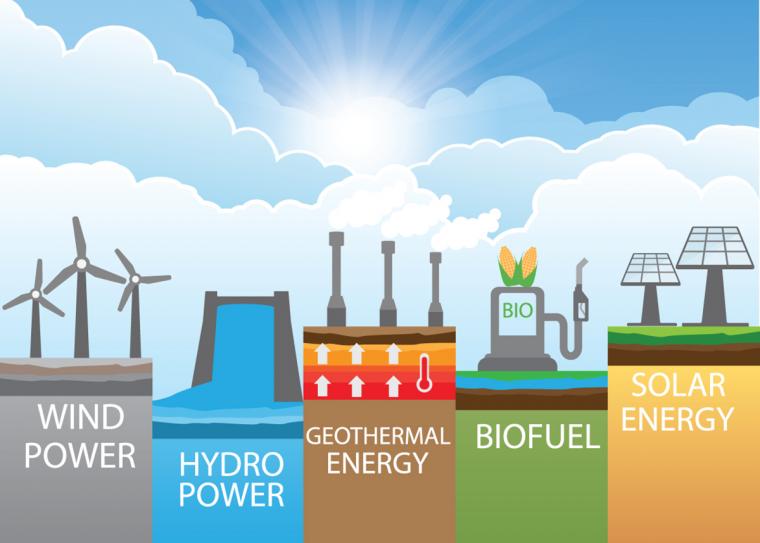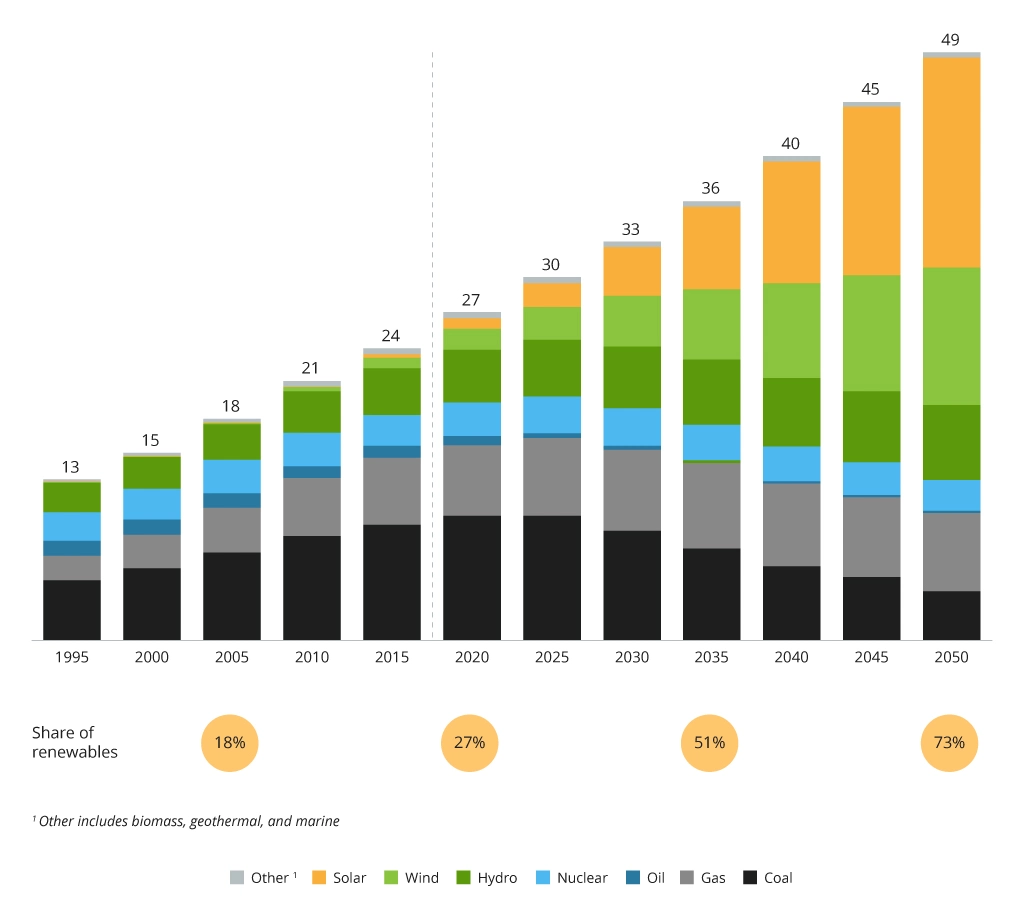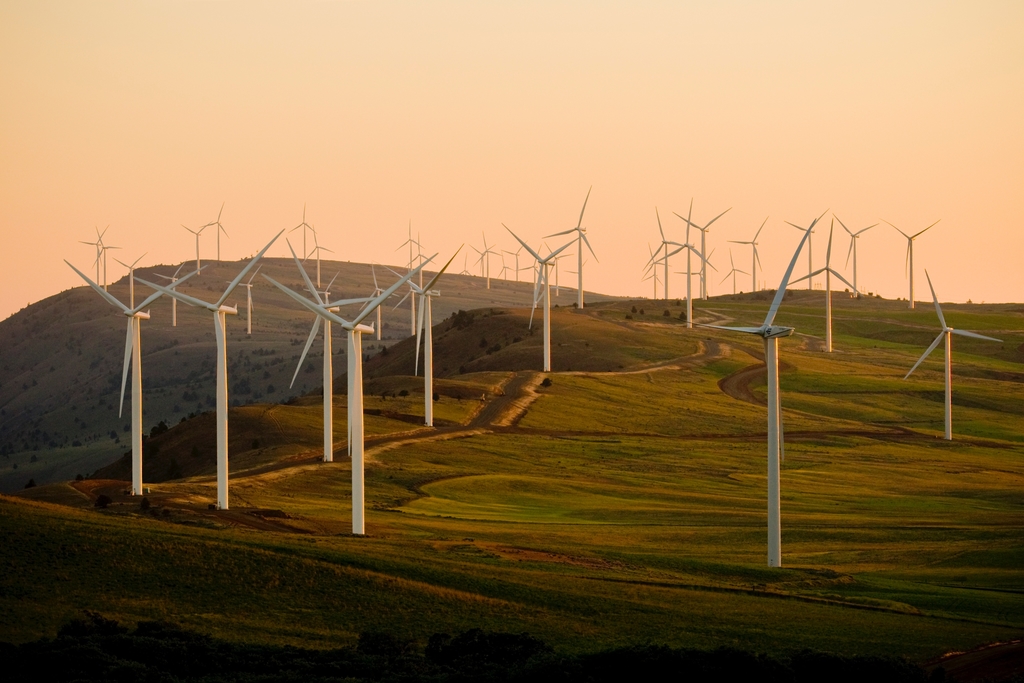The future of renewable energy looks promising and transformative. Advances in technology are driving significant changes in the energy landscape.
Renewable energy sources, such as solar, wind, and hydro, are becoming more efficient and cost-effective. Governments and businesses worldwide are investing heavily in clean energy solutions to combat climate change and reduce carbon emissions. Solar panels and wind turbines are now common sights, and innovations continue to improve their performance.
Energy storage technologies, like batteries, are also advancing rapidly, making renewable energy more reliable. The global shift towards sustainable energy is creating new job opportunities and fostering economic growth. As renewable energy becomes more accessible, it will play a crucial role in shaping a cleaner, greener future for everyone.
Global Trends
The world is shifting towards renewable energy. This change is driven by rising investments and supportive government policies. People and companies see the benefits of clean energy. Let’s explore these global trends.
Rising Investments
Money is flowing into renewable energy projects. Investors see the potential for growth. They know that clean energy is the future. Here are some key points:
- Billions of dollars are spent on solar and wind projects.
- New technologies are making renewable energy cheaper.
- Big companies are investing in clean energy.
Solar power and wind power are getting most of the investment. These are the most reliable sources of renewable energy. Other sources like hydro and geothermal are also growing.
Investments are not just from private companies. Governments and international organizations are also funding renewable energy. They see it as a way to fight climate change.
Government Policies
Many governments are creating policies to support renewable energy. These policies help make clean energy more affordable and accessible. Here are some examples:
| Country | Policy |
|---|---|
| USA | Tax credits for solar and wind projects |
| Germany | Feed-in tariffs for renewable energy |
| China | Subsidies for solar panel production |
These policies encourage companies to invest in renewable energy. They also make it easier for people to use clean energy at home. Some countries have set goals for reducing carbon emissions. They plan to reach these goals by using more renewable energy.
Governments are also investing in research. They want to find new ways to produce and store renewable energy. This research is leading to new technologies that are more efficient and less expensive.

Credit: www.tradeandindustrydev.com
Technological Advances
The future of renewable energy is bright. Technological advances are driving this transformation. Innovations in solar and wind energy are at the forefront. These breakthroughs make renewable energy more efficient and accessible.
Solar Innovations
Solar power is rapidly advancing. New technologies are making it more efficient. For example, perovskite solar cells are a game-changer. These cells are cheaper and more efficient than traditional ones.
Another innovation is the use of bifacial solar panels. These panels capture sunlight from both sides. This increases the energy output significantly.
Solar energy storage is also improving. Advanced batteries store more energy for longer periods. This ensures a steady power supply even when the sun isn’t shining.
| Innovation | Benefit |
|---|---|
| Perovskite Solar Cells | Cost-effective and highly efficient |
| Bifacial Solar Panels | Increased energy output |
| Advanced Batteries | Longer energy storage |
Wind Energy Breakthroughs
Wind energy is also seeing significant advances. One key development is the creation of floating wind turbines. These turbines can be placed in deeper waters where winds are stronger.
Vertical axis wind turbines are another breakthrough. They are more efficient in turbulent wind conditions. This makes them ideal for urban areas.
The use of artificial intelligence (AI) is enhancing wind energy efficiency. AI predicts weather patterns and optimizes turbine operation. This results in higher energy production.
- Floating wind turbines: Harness stronger winds in deep waters.
- Vertical axis wind turbines: Perform well in turbulent conditions.
- Artificial Intelligence: Optimizes turbine operation for maximum efficiency.
Energy Storage
The future of renewable energy hinges on efficient energy storage. This ensures a stable and reliable power supply. Energy storage technologies are advancing rapidly. They allow us to store excess energy generated by renewable sources.
Battery Technologies
Battery technologies are crucial for energy storage. They help store energy for use when needed. Among these, lithium-ion batteries are the most popular. They offer high energy density and efficiency. They are used in various applications, from electric cars to home energy systems.
Other promising battery technologies include:
- Solid-state batteries: These have higher energy densities and safety.
- Flow batteries: These are ideal for large-scale energy storage.
- Sodium-ion batteries: These are cheaper alternatives to lithium-ion batteries.
Battery advancements are critical for the future of renewable energy.
Grid Integration
Integrating energy storage with the grid is vital. It helps balance energy supply and demand. Smart grids play a key role here. They use advanced technologies to manage energy flow.
Key benefits of grid integration include:
- Enhanced reliability: Stored energy can be used during peak demand.
- Reduced costs: Energy storage can lower electricity prices.
- Improved efficiency: It minimizes energy losses in transmission.
Grid integration enables the seamless use of renewable energy. It ensures a consistent power supply.

Credit: www.infopulse.com
Sustainable Practices
The future of renewable energy depends on sustainable practices. These practices ensure that energy resources remain available for future generations. Sustainable practices also reduce environmental impact, helping our planet thrive.
Eco-friendly Manufacturing
Eco-friendly manufacturing is essential for renewable energy. This practice involves using green materials and processes. Companies focus on reducing waste and emissions during production.
Green materials include recycled metals and biodegradable plastics. These materials lessen the environmental footprint. Factories also use less water and energy, cutting down on pollution.
Implementing clean technologies is another aspect. Solar panels and wind turbines are made with minimal harm to nature. This ensures a cleaner future for all.
Circular Economy
A circular economy is vital for sustainability. This model reduces waste by reusing and recycling materials. It keeps resources in use for as long as possible.
| Principles | Benefits |
|---|---|
| Reduce | Lower resource consumption |
| Reuse | Extended product life |
| Recycle | Less waste in landfills |
In a circular economy, products are designed for durability. This means they last longer and are easier to repair. It helps in saving both resources and money.
Recycling is a key component. Materials from old products are used to make new ones. This reduces the need for raw materials and decreases pollution.
The circular economy also promotes innovation. New methods and technologies emerge to support sustainability. This leads to a greener and more efficient energy sector.
Economic Impacts
The future of renewable energy promises significant economic impacts. As the world shifts towards cleaner energy sources, the economic landscape will change. This transformation will bring numerous benefits, including job creation and cost reductions.
Job Creation
The renewable energy sector will create many new jobs. Solar and wind industries are growing fast. They need skilled workers for installation, maintenance, and innovation. This growth will provide opportunities for people in various fields.
Here is a table showing potential job growth in renewable energy:
| Sector | Job Growth (2025) |
|---|---|
| Solar Energy | 1 million jobs |
| Wind Energy | 500,000 jobs |
| Hydropower | 200,000 jobs |
These jobs will help reduce unemployment. They will also boost local economies. Communities will see new businesses and services emerge.
Cost Reductions
Renewable energy can lead to significant cost reductions. Solar and wind power have become cheaper than fossil fuels. This trend will continue as technology improves.
Here are some benefits of cost reductions:
- Lower electricity bills for consumers
- Reduced operational costs for businesses
- Decreased reliance on expensive fossil fuels
Governments also save money. They spend less on health care related to pollution. Investments in renewable energy will pay off in the long term. The cost of maintaining clean energy systems is low compared to traditional power plants.
Key Takeaways:
- Renewable energy creates new jobs.
- It leads to lower energy costs.
- It benefits local and global economies.
The economic impacts of renewable energy are clear. They promise a brighter, more sustainable future.

Credit: earth.org
Environmental Benefits
Renewable energy sources offer many environmental benefits. They help fight climate change and protect ecosystems. This section will explore the key benefits in detail.
Reduced Emissions
Using renewable energy sources like solar and wind power reduces greenhouse gas emissions. Fossil fuels release carbon dioxide and methane. These gases contribute to global warming.
Renewable energy produces little to no emissions. This helps keep our air clean and reduces the impact on global temperatures. Less pollution means healthier air for humans and wildlife.
Biodiversity Protection
Renewable energy helps protect biodiversity. Traditional energy sources, like coal and oil, harm ecosystems. They cause habitat destruction and pollution.
Renewable energy systems, like wind farms and solar panels, have a smaller footprint. They use less land and water. This helps preserve natural habitats and protect species from extinction.
Cleaner energy sources also reduce acid rain and water pollution. This benefits aquatic life and keeps water bodies healthy.
| Benefit | Renewable Energy | Fossil Fuels |
|---|---|---|
| Emissions | Low | High |
| Habitat Impact | Minimal | Severe |
| Pollution | Low | High |
Switching to renewable energy is crucial. It ensures a healthier planet for future generations.
Challenges Ahead
The future of renewable energy holds great promise. But there are significant challenges ahead. These challenges must be addressed to ensure a sustainable future.
Resource Scarcity
One major challenge is resource scarcity. Many renewable energy sources depend on rare materials. For example, lithium and cobalt are essential for batteries. These materials are limited and expensive. A shortage could slow down renewable energy adoption.
| Material | Usage in Renewable Energy | Availability |
|---|---|---|
| Lithium | Batteries | Limited |
| Cobalt | Batteries | Limited |
| Silicon | Solar Panels | Abundant |
Technological Barriers
Technological barriers also pose a significant challenge. Current technology is not always efficient. Wind turbines and solar panels need to be more efficient. Energy storage is another big issue. Today’s batteries cannot store enough energy for long periods.
Key technological challenges include:
- Improving energy storage capacity
- Enhancing the efficiency of solar panels
- Developing more effective wind turbines
These challenges require significant investment and research. Overcoming them is crucial for a greener future.
Future Predictions
The future of renewable energy looks bright and promising. Experts predict significant advancements in technology and market growth. These changes are expected to transform how we generate and use energy.
Market Growth
The renewable energy market is set to grow rapidly. According to recent studies, the global renewable energy market could reach $2.15 trillion by 2025. This growth is driven by an increasing demand for clean energy.
| Year | Market Value (in Trillions) |
|---|---|
| 2020 | $1.05 |
| 2021 | $1.25 |
| 2022 | $1.45 |
| 2023 | $1.75 |
| 2024 | $1.95 |
| 2025 | $2.15 |
Government policies and investments also play a crucial role. Many countries are setting ambitious targets for renewable energy adoption. This is encouraging more investment in the sector.
Emerging Technologies
New technologies are emerging in the renewable energy sector. These innovations promise to make renewable energy more efficient and affordable.
- Solar Power: Advances in solar panel efficiency are making solar energy more viable.
- Wind Energy: New turbine designs are capturing more wind energy.
- Energy Storage: Improved batteries are storing more energy for longer periods.
Other technologies like hydrogen fuel cells and tidal energy are also gaining traction. These technologies have the potential to revolutionize the energy landscape.
Research and development are key to these advancements. Continuous innovation will drive the future of renewable energy.
Conclusion
Renewable energy is key to a sustainable future. Innovations and investments are accelerating its growth. Communities worldwide are embracing cleaner alternatives. The shift to renewables is not just necessary but inevitable. Staying informed and supporting green initiatives can help ensure a brighter, more sustainable future for all.

